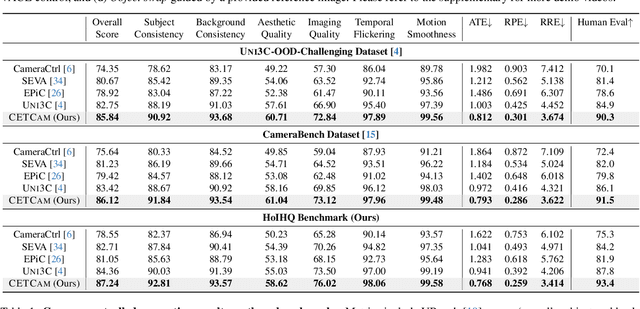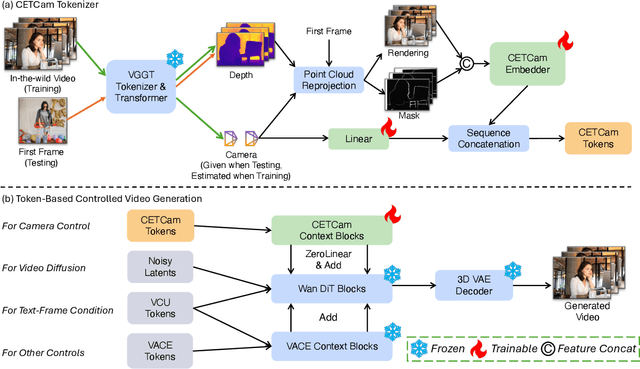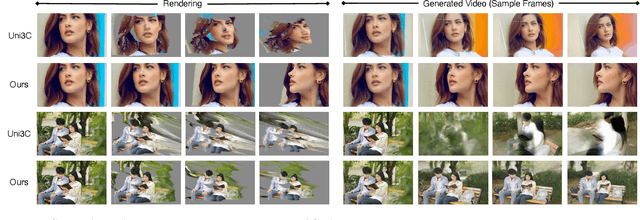Ziyang Song
Depth Anything in $360^\circ$: Towards Scale Invariance in the Wild
Dec 28, 2025Abstract:Panoramic depth estimation provides a comprehensive solution for capturing complete $360^\circ$ environmental structural information, offering significant benefits for robotics and AR/VR applications. However, while extensively studied in indoor settings, its zero-shot generalization to open-world domains lags far behind perspective images, which benefit from abundant training data. This disparity makes transferring capabilities from the perspective domain an attractive solution. To bridge this gap, we present Depth Anything in $360^\circ$ (DA360), a panoramic-adapted version of Depth Anything V2. Our key innovation involves learning a shift parameter from the ViT backbone, transforming the model's scale- and shift-invariant output into a scale-invariant estimate that directly yields well-formed 3D point clouds. This is complemented by integrating circular padding into the DPT decoder to eliminate seam artifacts, ensuring spatially coherent depth maps that respect spherical continuity. Evaluated on standard indoor benchmarks and our newly curated outdoor dataset, Metropolis, DA360 shows substantial gains over its base model, achieving over 50\% and 10\% relative depth error reduction on indoor and outdoor benchmarks, respectively. Furthermore, DA360 significantly outperforms robust panoramic depth estimation methods, achieving about 30\% relative error improvement compared to PanDA across all three test datasets and establishing new state-of-the-art performance for zero-shot panoramic depth estimation.
ByteLoom: Weaving Geometry-Consistent Human-Object Interactions through Progressive Curriculum Learning
Dec 28, 2025Abstract:Human-object interaction (HOI) video generation has garnered increasing attention due to its promising applications in digital humans, e-commerce, advertising, and robotics imitation learning. However, existing methods face two critical limitations: (1) a lack of effective mechanisms to inject multi-view information of the object into the model, leading to poor cross-view consistency, and (2) heavy reliance on fine-grained hand mesh annotations for modeling interaction occlusions. To address these challenges, we introduce ByteLoom, a Diffusion Transformer (DiT)-based framework that generates realistic HOI videos with geometrically consistent object illustration, using simplified human conditioning and 3D object inputs. We first propose an RCM-cache mechanism that leverages Relative Coordinate Maps (RCM) as a universal representation to maintain object's geometry consistency and precisely control 6-DoF object transformations in the meantime. To compensate HOI dataset scarcity and leverage existing datasets, we further design a training curriculum that enhances model capabilities in a progressive style and relaxes the demand of hand mesh. Extensive experiments demonstrate that our method faithfully preserves human identity and the object's multi-view geometry, while maintaining smooth motion and object manipulation.
Anatomy-R1: Enhancing Anatomy Reasoning in Multimodal Large Language Models via Anatomical Similarity Curriculum and Group Diversity Augmentation
Dec 24, 2025Abstract:Multimodal Large Language Models (MLLMs) have achieved impressive progress in natural image reasoning, yet their potential in medical imaging remains underexplored, especially in clinical anatomical surgical images. Anatomy understanding tasks demand precise understanding and clinically coherent answers, which are difficult to achieve due to the complexity of medical data and the scarcity of high-quality expert annotations. These challenges limit the effectiveness of conventional Supervised Fine-Tuning (SFT) strategies. While recent work has demonstrated that Group Relative Policy Optimization (GRPO) can enhance reasoning in MLLMs without relying on large amounts of data, we find two weaknesses that hinder GRPO's reasoning performance in anatomy recognition: 1) knowledge cannot be effectively shared between different anatomical structures, resulting in uneven information gain and preventing the model from converging, and 2) the model quickly converges to a single reasoning path, suppressing the exploration of diverse strategies. To overcome these challenges, we propose two novel methods. First, we implement a progressive learning strategy called Anatomical Similarity Curriculum Learning by controlling question difficulty via the similarity of answer choices, enabling the model to master complex problems incrementally. Second, we utilize question augmentation referred to as Group Diversity Question Augmentation to expand the model's search space for difficult queries, mitigating the tendency to produce uniform responses. Comprehensive experiments on the SGG-VQA and OmniMedVQA benchmarks show our method achieves a significant improvement across the two benchmarks, demonstrating its effectiveness in enhancing the medical reasoning capabilities of MLLMs. The code can be found in https://github.com/tomato996/Anatomy-R1
CETCAM: Camera-Controllable Video Generation via Consistent and Extensible Tokenization
Dec 22, 2025



Abstract:Achieving precise camera control in video generation remains challenging, as existing methods often rely on camera pose annotations that are difficult to scale to large and dynamic datasets and are frequently inconsistent with depth estimation, leading to train-test discrepancies. We introduce CETCAM, a camera-controllable video generation framework that eliminates the need for camera annotations through a consistent and extensible tokenization scheme. CETCAM leverages recent advances in geometry foundation models, such as VGGT, to estimate depth and camera parameters and converts them into unified, geometry-aware tokens. These tokens are seamlessly integrated into a pretrained video diffusion backbone via lightweight context blocks. Trained in two progressive stages, CETCAM first learns robust camera controllability from diverse raw video data and then refines fine-grained visual quality using curated high-fidelity datasets. Extensive experiments across multiple benchmarks demonstrate state-of-the-art geometric consistency, temporal stability, and visual realism. Moreover, CETCAM exhibits strong adaptability to additional control modalities, including inpainting and layout control, highlighting its flexibility beyond camera control. The project page is available at https://sjtuytc.github.io/CETCam_project_page.github.io/.
Cross-modal Retrieval Models for Stripped Binary Analysis
Dec 11, 2025Abstract:LLM-agent based binary code analysis has demonstrated significant potential across a wide range of software security scenarios, including vulnerability detection, malware analysis, etc. In agent workflow, however, retrieving the positive from thousands of stripped binary functions based on user query remains under-studied and challenging, as the absence of symbolic information distinguishes it from source code retrieval. In this paper, we introduce, BinSeek, the first two-stage cross-modal retrieval framework for stripped binary code analysis. It consists of two models: BinSeekEmbedding is trained on large-scale dataset to learn the semantic relevance of the binary code and the natural language description, furthermore, BinSeek-Reranker learns to carefully judge the relevance of the candidate code to the description with context augmentation. To this end, we built an LLM-based data synthesis pipeline to automate training construction, also deriving a domain benchmark for future research. Our evaluation results show that BinSeek achieved the state-of-the-art performance, surpassing the the same scale models by 31.42% in Rec@3 and 27.17% in MRR@3, as well as leading the advanced general-purpose models that have 16 times larger parameters.
Multimodal Causal-Driven Representation Learning for Generalizable Medical Image Segmentation
Aug 07, 2025Abstract:Vision-Language Models (VLMs), such as CLIP, have demonstrated remarkable zero-shot capabilities in various computer vision tasks. However, their application to medical imaging remains challenging due to the high variability and complexity of medical data. Specifically, medical images often exhibit significant domain shifts caused by various confounders, including equipment differences, procedure artifacts, and imaging modes, which can lead to poor generalization when models are applied to unseen domains. To address this limitation, we propose Multimodal Causal-Driven Representation Learning (MCDRL), a novel framework that integrates causal inference with the VLM to tackle domain generalization in medical image segmentation. MCDRL is implemented in two steps: first, it leverages CLIP's cross-modal capabilities to identify candidate lesion regions and construct a confounder dictionary through text prompts, specifically designed to represent domain-specific variations; second, it trains a causal intervention network that utilizes this dictionary to identify and eliminate the influence of these domain-specific variations while preserving the anatomical structural information critical for segmentation tasks. Extensive experiments demonstrate that MCDRL consistently outperforms competing methods, yielding superior segmentation accuracy and exhibiting robust generalizability.
FreeGave: 3D Physics Learning from Dynamic Videos by Gaussian Velocity
Jun 09, 2025Abstract:In this paper, we aim to model 3D scene geometry, appearance, and the underlying physics purely from multi-view videos. By applying various governing PDEs as PINN losses or incorporating physics simulation into neural networks, existing works often fail to learn complex physical motions at boundaries or require object priors such as masks or types. In this paper, we propose FreeGave to learn the physics of complex dynamic 3D scenes without needing any object priors. The key to our approach is to introduce a physics code followed by a carefully designed divergence-free module for estimating a per-Gaussian velocity field, without relying on the inefficient PINN losses. Extensive experiments on three public datasets and a newly collected challenging real-world dataset demonstrate the superior performance of our method for future frame extrapolation and motion segmentation. Most notably, our investigation into the learned physics codes reveals that they truly learn meaningful 3D physical motion patterns in the absence of any human labels in training.
DepthMaster: Taming Diffusion Models for Monocular Depth Estimation
Jan 05, 2025



Abstract:Monocular depth estimation within the diffusion-denoising paradigm demonstrates impressive generalization ability but suffers from low inference speed. Recent methods adopt a single-step deterministic paradigm to improve inference efficiency while maintaining comparable performance. However, they overlook the gap between generative and discriminative features, leading to suboptimal results. In this work, we propose DepthMaster, a single-step diffusion model designed to adapt generative features for the discriminative depth estimation task. First, to mitigate overfitting to texture details introduced by generative features, we propose a Feature Alignment module, which incorporates high-quality semantic features to enhance the denoising network's representation capability. Second, to address the lack of fine-grained details in the single-step deterministic framework, we propose a Fourier Enhancement module to adaptively balance low-frequency structure and high-frequency details. We adopt a two-stage training strategy to fully leverage the potential of the two modules. In the first stage, we focus on learning the global scene structure with the Feature Alignment module, while in the second stage, we exploit the Fourier Enhancement module to improve the visual quality. Through these efforts, our model achieves state-of-the-art performance in terms of generalization and detail preservation, outperforming other diffusion-based methods across various datasets. Our project page can be found at https://indu1ge.github.io/DepthMaster_page.
DeepSeek-V3 Technical Report
Dec 27, 2024



Abstract:We present DeepSeek-V3, a strong Mixture-of-Experts (MoE) language model with 671B total parameters with 37B activated for each token. To achieve efficient inference and cost-effective training, DeepSeek-V3 adopts Multi-head Latent Attention (MLA) and DeepSeekMoE architectures, which were thoroughly validated in DeepSeek-V2. Furthermore, DeepSeek-V3 pioneers an auxiliary-loss-free strategy for load balancing and sets a multi-token prediction training objective for stronger performance. We pre-train DeepSeek-V3 on 14.8 trillion diverse and high-quality tokens, followed by Supervised Fine-Tuning and Reinforcement Learning stages to fully harness its capabilities. Comprehensive evaluations reveal that DeepSeek-V3 outperforms other open-source models and achieves performance comparable to leading closed-source models. Despite its excellent performance, DeepSeek-V3 requires only 2.788M H800 GPU hours for its full training. In addition, its training process is remarkably stable. Throughout the entire training process, we did not experience any irrecoverable loss spikes or perform any rollbacks. The model checkpoints are available at https://github.com/deepseek-ai/DeepSeek-V3.
P2DFlow: A Protein Ensemble Generative Model with SE(3) Flow Matching
Nov 26, 2024Abstract:Biological processes, functions, and properties are intricately linked to the ensemble of protein conformations, rather than being solely determined by a single stable conformation. In this study, we have developed P2DFlow, a generative model based on SE(3) flow matching, to predict the structural ensembles of proteins. We specifically designed a valuable prior for the flow process and enhanced the model's ability to distinguish each intermediate state by incorporating an additional dimension to describe the ensemble data, which can reflect the physical laws governing the distribution of ensembles, so that the prior knowledge can effectively guide the generation process. When trained and evaluated on the MD datasets of ATLAS, P2DFlow outperforms other baseline models on extensive experiments, successfully capturing the observable dynamic fluctuations as evidenced in crystal structure and MD simulations. As a potential proxy agent for protein molecular simulation, the high-quality ensembles generated by P2DFlow could significantly aid in understanding protein functions across various scenarios. Code is available at https://github.com/BLEACH366/P2DFlow.
 Add to Chrome
Add to Chrome Add to Firefox
Add to Firefox Add to Edge
Add to Edge